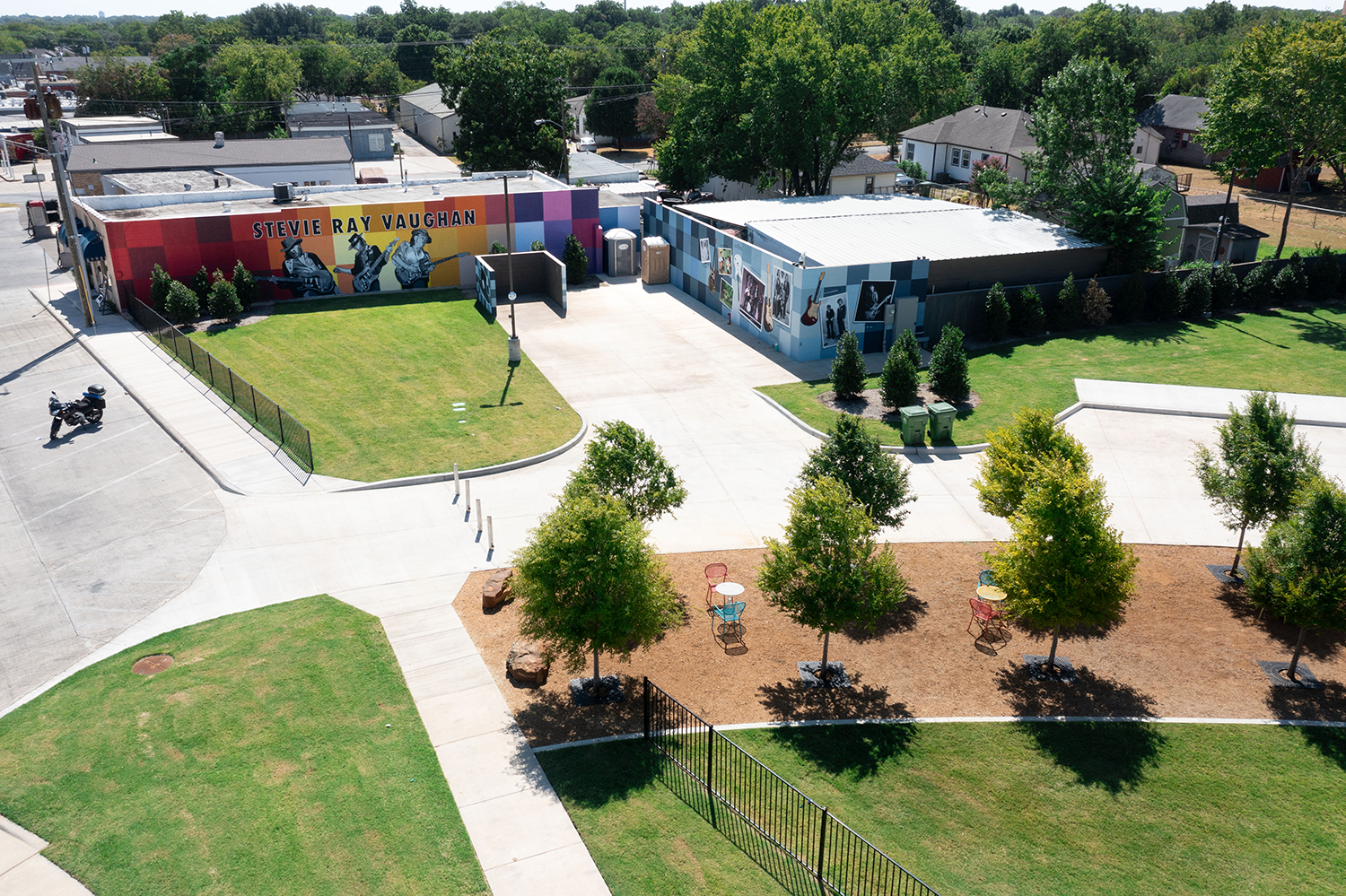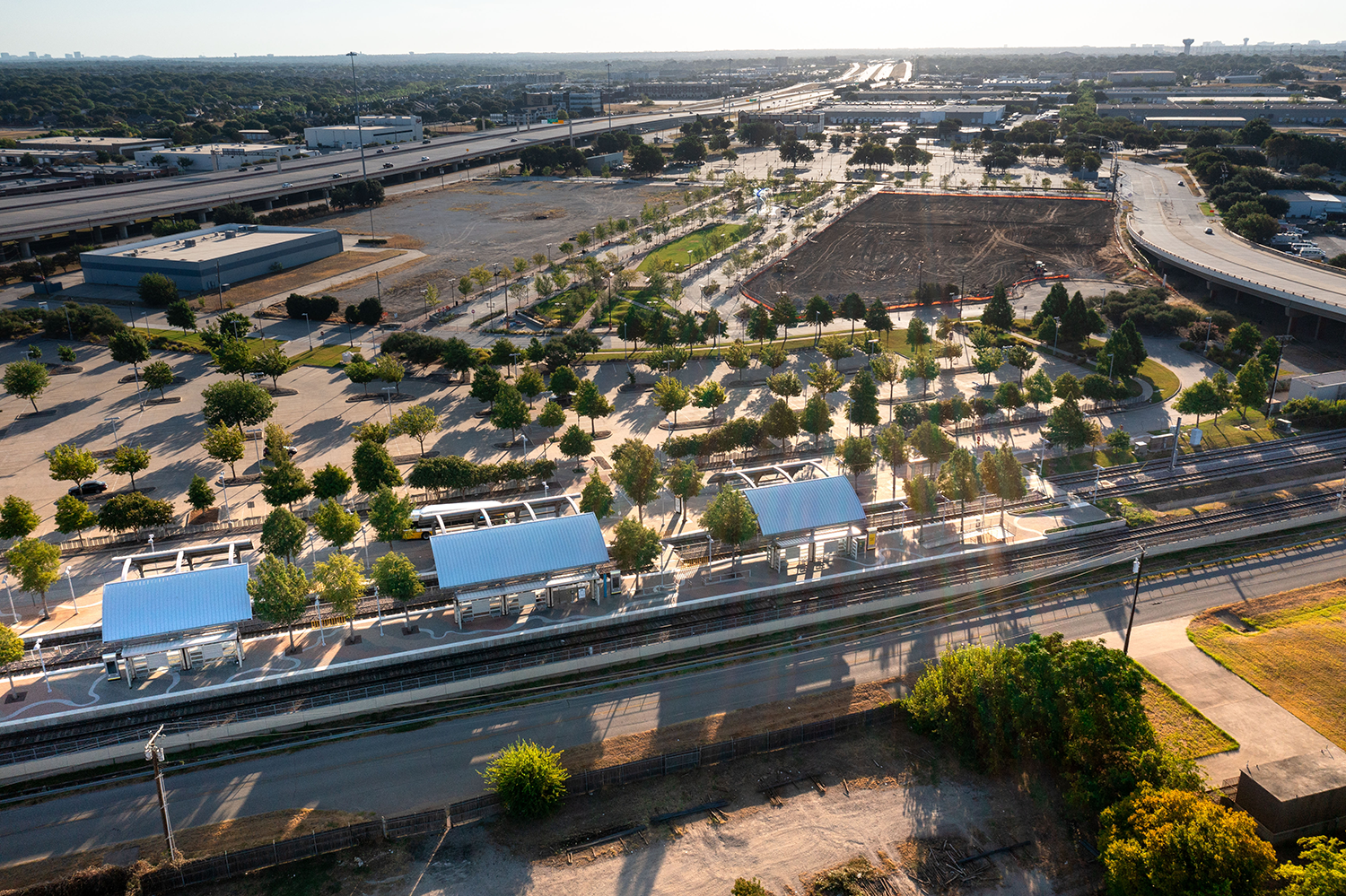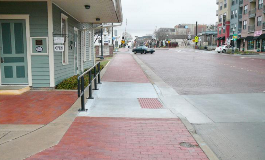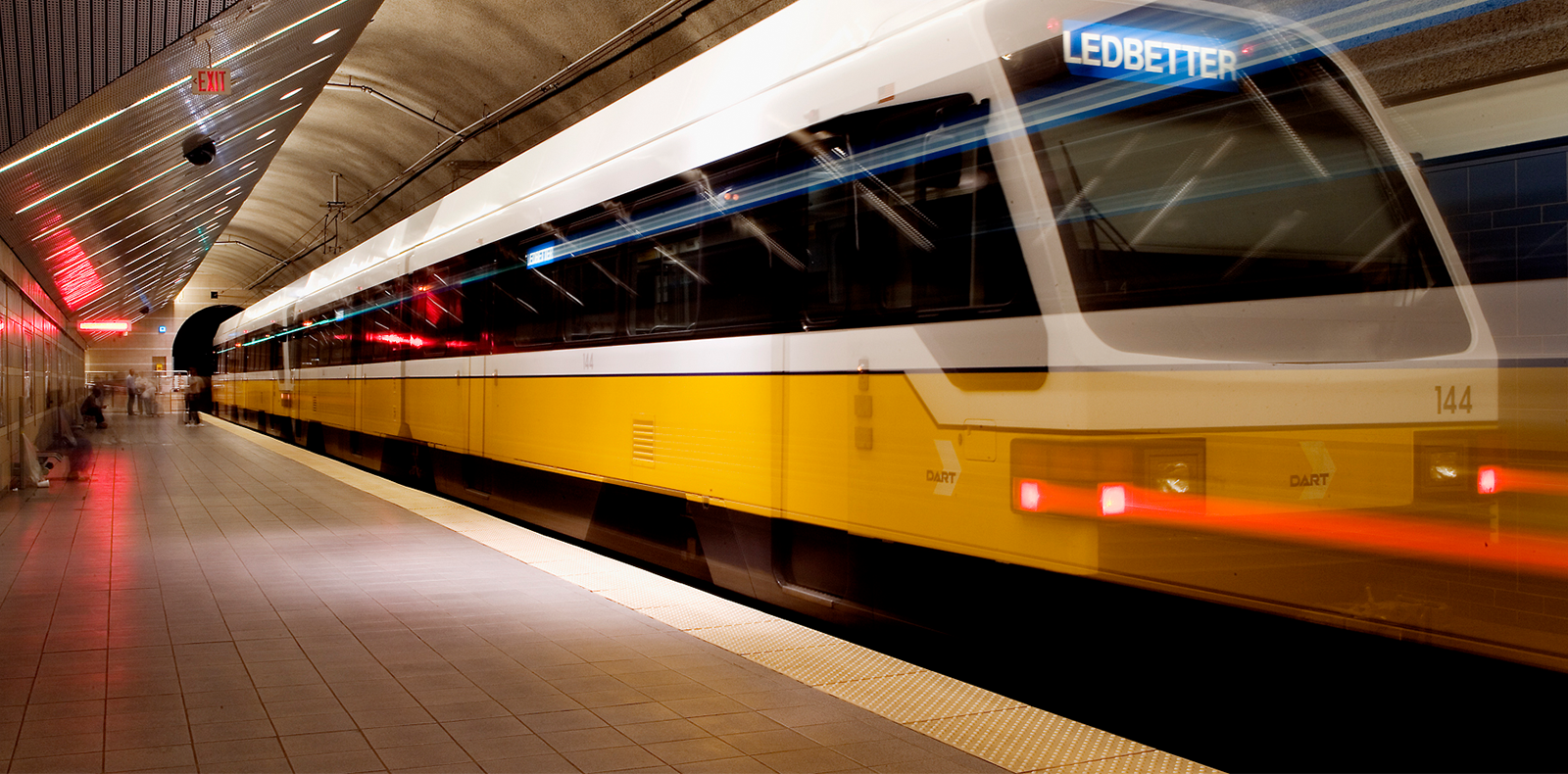- Ask DART
- About
- News
Area Plans Will Align DART Efforts with Service Area Cities’ Goals
 Stevie Ray Vaughan Park near Cockrell Hill PTL
Stevie Ray Vaughan Park near Cockrell Hill PTL
City leaders in the DART Service Area have new opportunities to collaborate with DART on how it can best benefit their community and support their own strategic visions.
This past August, the agency kicked off an initiative called Area Plans aimed at discovering where city goals and DART goals align to better identify policies and projects that would increase transit use and economic growth. The final product will be a unique, phased program outlining projects and opportunities that take advantage of each city’s capital improvement plans and DART’s own plans.
This collaborative approach to transit planning is in line with our agency’s vision to be an economic and mobility asset to the cities we serve. In terms of DART’s strategic plan, the Area Plans effort supports our goals to create seamless travel experiences, fantastic spaces that add value to our communities, and strategic relationships that advance common aspirations.
Initial meetings sought to identify city plans
Phase 1, which began in August, involved initial meetings and city tours in each of our cities. We met with city managers and senior staff from the municipal transportation, planning, engineering, and economic development departments. I brought a small team of DART staff from our capital planning, service planning, economic development, and community engagement teams.
To date, we have visited 12 of 13 cities. The meeting with the final city will be scheduled soon.
DART came to these meetings and tours in listening mode. We wanted to learn what is planned and important to the city leaders in terms of mobility, land use, and economic development. Our intent was to understand the goals, plans, and vision that each city has for its growth and try to find common ground, transportation gaps, and potential opportunities.
Passenger facilities can become fantastic spaces
Area Plans will also outline ways that DART can add value to each community beyond adding more service.
For example, an easy win would be to work with cities to transform our rail stations and bus transit centers into mobility hubs. These hubs are locations where people can access multiple types of transportation modes, including transit, ridesharing, electric vehicle charging, scooter rentals, bike-sharing, and more.
 The agency is also seeking more opportunities to collaborate with cities and private developers to revitalize properties immediately at or adjacent to our passenger facilities to activate vacant land or underutilized parking lots. Everyone benefits if we can leverage DART assets to create vibrant urban spaces that attract people to visit and dwell in the area.
The agency is also seeking more opportunities to collaborate with cities and private developers to revitalize properties immediately at or adjacent to our passenger facilities to activate vacant land or underutilized parking lots. Everyone benefits if we can leverage DART assets to create vibrant urban spaces that attract people to visit and dwell in the area.
A great example is the Trinity Mills Station project where DART and the City of Carrollton jointly marketed their combined 25-acre vacant lots. Now private developers are constructing a walkable, mixed-use development that, when finished, will draw riders to DART and DCTA, while also creating a new public space for the city of Carrollton and others throughout the region to enjoy.Next steps include travel pattern analysis, workshops
In Phase 2, DART staff will prepare a travel pattern analysis, an existing conditions report, a summary of what we have learned, and work with city staff to develop a list of action items and opportunities for each city. Throughout the rest of the year, we plan to hold a series of workshops with city staff to brainstorm ideas and continue the discussion of ways we can collaborate to advance our mutual goals.
My hope is that together, we can identify city infrastructure projects – such as street redesigns or sidewalk reconstruction – that could be modified to make riding public transit easier, faster, and more attractive to residents and workers. The agency also wants to discover what new destinations may open in the next decade so that DART can be proactive in planning service to those areas. Lastly, we hope to find external funding sources available to cities or DART that could accelerate the implementation of projects that benefit both entities.
I will have more updates for you on Area Plans as we reach significant milestones.
Photos:
The City of Cockrell Hill built the Stevie Ray Vaughan Park on a vacant lot across from DART’s Cockrell Hill Passenger Transfer Location.
The City of Carrollton and DART are working with private developers to create a mixed-use district on their combined 25-acre property next to, and sharing a name with, Trinity Mills Station.
The City of Plano’s paver reconstruction project along 15th Street in Downtown Plano improved pedestrian access to Downtown Plano Station.
Categories : Leading Mobility - Community
Area Plans Will Align DART Efforts with Service Area Cities’ Goals
 Stevie Ray Vaughan Park near Cockrell Hill PTL
Stevie Ray Vaughan Park near Cockrell Hill PTL
City leaders in the DART Service Area have new opportunities to collaborate with DART on how it can best benefit their community and support their own strategic visions.
This past August, the agency kicked off an initiative called Area Plans aimed at discovering where city goals and DART goals align to better identify policies and projects that would increase transit use and economic growth. The final product will be a unique, phased program outlining projects and opportunities that take advantage of each city’s capital improvement plans and DART’s own plans.
This collaborative approach to transit planning is in line with our agency’s vision to be an economic and mobility asset to the cities we serve. In terms of DART’s strategic plan, the Area Plans effort supports our goals to create seamless travel experiences, fantastic spaces that add value to our communities, and strategic relationships that advance common aspirations.
Initial meetings sought to identify city plans
Phase 1, which began in August, involved initial meetings and city tours in each of our cities. We met with city managers and senior staff from the municipal transportation, planning, engineering, and economic development departments. I brought a small team of DART staff from our capital planning, service planning, economic development, and community engagement teams.
To date, we have visited 12 of 13 cities. The meeting with the final city will be scheduled soon.
DART came to these meetings and tours in listening mode. We wanted to learn what is planned and important to the city leaders in terms of mobility, land use, and economic development. Our intent was to understand the goals, plans, and vision that each city has for its growth and try to find common ground, transportation gaps, and potential opportunities.
Passenger facilities can become fantastic spaces
Area Plans will also outline ways that DART can add value to each community beyond adding more service.
For example, an easy win would be to work with cities to transform our rail stations and bus transit centers into mobility hubs. These hubs are locations where people can access multiple types of transportation modes, including transit, ridesharing, electric vehicle charging, scooter rentals, bike-sharing, and more.
 The agency is also seeking more opportunities to collaborate with cities and private developers to revitalize properties immediately at or adjacent to our passenger facilities to activate vacant land or underutilized parking lots. Everyone benefits if we can leverage DART assets to create vibrant urban spaces that attract people to visit and dwell in the area.
The agency is also seeking more opportunities to collaborate with cities and private developers to revitalize properties immediately at or adjacent to our passenger facilities to activate vacant land or underutilized parking lots. Everyone benefits if we can leverage DART assets to create vibrant urban spaces that attract people to visit and dwell in the area.
A great example is the Trinity Mills Station project where DART and the City of Carrollton jointly marketed their combined 25-acre vacant lots. Now private developers are constructing a walkable, mixed-use development that, when finished, will draw riders to DART and DCTA, while also creating a new public space for the city of Carrollton and others throughout the region to enjoy.Next steps include travel pattern analysis, workshops
In Phase 2, DART staff will prepare a travel pattern analysis, an existing conditions report, a summary of what we have learned, and work with city staff to develop a list of action items and opportunities for each city. Throughout the rest of the year, we plan to hold a series of workshops with city staff to brainstorm ideas and continue the discussion of ways we can collaborate to advance our mutual goals.
My hope is that together, we can identify city infrastructure projects – such as street redesigns or sidewalk reconstruction – that could be modified to make riding public transit easier, faster, and more attractive to residents and workers. The agency also wants to discover what new destinations may open in the next decade so that DART can be proactive in planning service to those areas. Lastly, we hope to find external funding sources available to cities or DART that could accelerate the implementation of projects that benefit both entities.
I will have more updates for you on Area Plans as we reach significant milestones.
Photos:
The City of Cockrell Hill built the Stevie Ray Vaughan Park on a vacant lot across from DART’s Cockrell Hill Passenger Transfer Location.
The City of Carrollton and DART are working with private developers to create a mixed-use district on their combined 25-acre property next to, and sharing a name with, Trinity Mills Station.
The City of Plano’s paver reconstruction project along 15th Street in Downtown Plano improved pedestrian access to Downtown Plano Station.
Categories : Leading Mobility - Knowledge
Area Plans Will Align DART Efforts with Service Area Cities’ Goals
 Stevie Ray Vaughan Park near Cockrell Hill PTL
Stevie Ray Vaughan Park near Cockrell Hill PTL
City leaders in the DART Service Area have new opportunities to collaborate with DART on how it can best benefit their community and support their own strategic visions.
This past August, the agency kicked off an initiative called Area Plans aimed at discovering where city goals and DART goals align to better identify policies and projects that would increase transit use and economic growth. The final product will be a unique, phased program outlining projects and opportunities that take advantage of each city’s capital improvement plans and DART’s own plans.
This collaborative approach to transit planning is in line with our agency’s vision to be an economic and mobility asset to the cities we serve. In terms of DART’s strategic plan, the Area Plans effort supports our goals to create seamless travel experiences, fantastic spaces that add value to our communities, and strategic relationships that advance common aspirations.
Initial meetings sought to identify city plans
Phase 1, which began in August, involved initial meetings and city tours in each of our cities. We met with city managers and senior staff from the municipal transportation, planning, engineering, and economic development departments. I brought a small team of DART staff from our capital planning, service planning, economic development, and community engagement teams.
To date, we have visited 12 of 13 cities. The meeting with the final city will be scheduled soon.
DART came to these meetings and tours in listening mode. We wanted to learn what is planned and important to the city leaders in terms of mobility, land use, and economic development. Our intent was to understand the goals, plans, and vision that each city has for its growth and try to find common ground, transportation gaps, and potential opportunities.
Passenger facilities can become fantastic spaces
Area Plans will also outline ways that DART can add value to each community beyond adding more service.
For example, an easy win would be to work with cities to transform our rail stations and bus transit centers into mobility hubs. These hubs are locations where people can access multiple types of transportation modes, including transit, ridesharing, electric vehicle charging, scooter rentals, bike-sharing, and more.
 The agency is also seeking more opportunities to collaborate with cities and private developers to revitalize properties immediately at or adjacent to our passenger facilities to activate vacant land or underutilized parking lots. Everyone benefits if we can leverage DART assets to create vibrant urban spaces that attract people to visit and dwell in the area.
The agency is also seeking more opportunities to collaborate with cities and private developers to revitalize properties immediately at or adjacent to our passenger facilities to activate vacant land or underutilized parking lots. Everyone benefits if we can leverage DART assets to create vibrant urban spaces that attract people to visit and dwell in the area.
A great example is the Trinity Mills Station project where DART and the City of Carrollton jointly marketed their combined 25-acre vacant lots. Now private developers are constructing a walkable, mixed-use development that, when finished, will draw riders to DART and DCTA, while also creating a new public space for the city of Carrollton and others throughout the region to enjoy.Next steps include travel pattern analysis, workshops
In Phase 2, DART staff will prepare a travel pattern analysis, an existing conditions report, a summary of what we have learned, and work with city staff to develop a list of action items and opportunities for each city. Throughout the rest of the year, we plan to hold a series of workshops with city staff to brainstorm ideas and continue the discussion of ways we can collaborate to advance our mutual goals.
My hope is that together, we can identify city infrastructure projects – such as street redesigns or sidewalk reconstruction – that could be modified to make riding public transit easier, faster, and more attractive to residents and workers. The agency also wants to discover what new destinations may open in the next decade so that DART can be proactive in planning service to those areas. Lastly, we hope to find external funding sources available to cities or DART that could accelerate the implementation of projects that benefit both entities.
I will have more updates for you on Area Plans as we reach significant milestones.
Photos:
The City of Cockrell Hill built the Stevie Ray Vaughan Park on a vacant lot across from DART’s Cockrell Hill Passenger Transfer Location.
The City of Carrollton and DART are working with private developers to create a mixed-use district on their combined 25-acre property next to, and sharing a name with, Trinity Mills Station.
The City of Plano’s paver reconstruction project along 15th Street in Downtown Plano improved pedestrian access to Downtown Plano Station.
Categories : Leading Mobility - Leading Mobility
- language





 Translate
Translate
Leave a comment